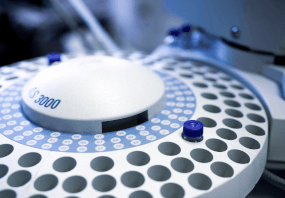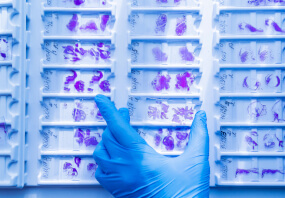General description
Bridging integrator-1 (BIN1), also called amphiphysin II, is a nucleocytoplasmic protein which is ubiquitously expressed. It is a ligand to the transcription factor Myc and also interacts with SRC SH3, which is a tyrosine kinase ligand. Amphiphysin II is a member of the amphiphysin family, along with amphiphysin I. Depending upon the cell type, human BIN1 gene is alternatively spliced. In humans, BIN1 gene is located on chromosome 2q14 and has 20 exons. Gene splicing leads to various isoforms, of which isoform 8 is found in skeletal muscles, 1 to 7 in brain and 9 and 10 are expressed ubiquitously. It is also called SH3P9, and has an N-BAR (Bin-amphiphysin/Rvs) domain, a phosphoinositide (PI) binding motif, clathrin and AP2 (CLAP) binding domain, Myc-binding domain (MBD) as well as SRC homology 3 domain.
Immunogen
Myc box-dependent-interacting protein 1 recombinant protein epitope signature tag (PrEST)
Application
All Prestige Antibodies Powered by Atlas Antibodies are developed and validated by the Human Protein Atlas (HPA) project and as a result, are supported by the most extensive characterization in the industry.
The Human Protein Atlas project can be subdivided into three efforts: Human Tissue Atlas, Cancer Atlas, and Human Cell Atlas. The antibodies that have been generated in support of the Tissue and Cancer Atlas projects have been tested by immunohistochemistry against hundreds of normal and disease tissues and through the recent efforts of the Human Cell Atlas project, many have been characterized by immunofluorescence to map the human proteome not only at the tissue level but now at the subcellular level. These images and the collection of this vast data set can be viewed on the Human Protein Atlas (HPA) site by clicking on the Image Gallery link. We also provide Prestige Antibodies® protocols and other useful information.
Biochem/physiol Actions
The N-terminal BAR domain of Bridging integrator-1 (BIN1) is responsible for the regulation of membrane curvature sensing and generation (MC-S&G). This function of BIN1, in turn is regulated and auto-inhibited by the PI binding motif and the SH3 domain, which recruit downstream proteins such as dynamin-2. It interacts with Myc oncoproteins and acts as a tumor suppressor gene, and therefore, its expression is reduced in cancer cells. BIN1 also mediates endocytosis in brain by binding to AP2 and clathrin, which are endocytic proteins. BIN1 mediates endocytosis, cell migration, and endosomal sorting through membrane remodeling. This is achieved via its N-BAR domain, which mediates the formation of plasma membrane invaginations (T-tubules) in muscles. Centronuclear myopathy (CNM) has been linked to 3 mutations in the N-BAR gene, namely, K35N, D151N and R154Q. It has also been linked to late-onset Alzheimer′s disease and heart failure.
Features and Benefits
Prestige Antibodies® are highly characterized and extensively validated antibodies with the added benefit of all available characterization data for each target being accessible via the Human Protein Atlas portal linked just below the product name at the top of this page. The uniqueness and low cross-reactivity of the Prestige Antibodies® to other proteins are due to a thorough selection of antigen regions, affinity purification, and stringent selection. Prestige antigen controls are available for every corresponding Prestige Antibody and can be found in the linkage section.
Every Prestige Antibody is tested in the following ways:
- IHC tissue array of 44 normal human tissues and 20 of the most common cancer type tissues.
- Protein array of 364 human recombinant protein fragments.
Linkage
Corresponding Antigen APREST70745.
Physical form
Solution in phosphate-buffered saline, pH 7.2, containing 40% glycerol and 0.02% sodium azide
Legal Information
Prestige Antibodies is a registered trademark of Sigma-Aldrich Co. LLC
- UPC:
- 51282907
- Condition:
- New
- Availability:
- 3-5 Dyas
- Weight:
- 1.00 Ounces
- HazmatClass:
- No
- WeightUOM:
- LB
- MPN:
- HPA005437-25UL
- Product Size:
- 25UL












